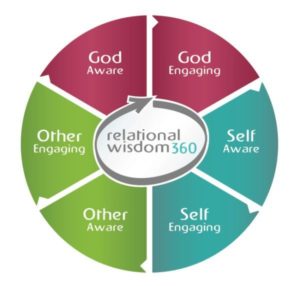God designed us to be three-dimensional in our relationships. Align yourself with this design, and your relationships prosper. Ignore it and they will inevitably suffer. The is the uniform message of Holy Scripture, early church patriarchs, and more recent theologians like C.S. Lewis, John Stott, John Frame and Tim Keller.
The 3D’s Are Everywhere
From Genesis to Revelation, the Bible teaches us how to relate to God (love, trust, worship, obey), how to discipline ourselves (search your heart, self-control, put off/put on), and how to relate to our neighbors (love, forgive, encourage, serve).
 This triad of teaching may be represented as a circle (what we call the “relational wisdom® (RW) paradigm”) comprised of three major sections: God-aware/engaging, Self-aware/engaging, and Other-aware/engaging (see Discover RW for an explanation of these terms).
This triad of teaching may be represented as a circle (what we call the “relational wisdom® (RW) paradigm”) comprised of three major sections: God-aware/engaging, Self-aware/engaging, and Other-aware/engaging (see Discover RW for an explanation of these terms).
Many passages in the Bible address all three dimensions. They start with a focus on knowing and loving God, move on to teach us how to understand and discipline ourselves, and then show us how to empathize with and serve our neighbors. Sometimes they do a full 360 and close by focusing our attention on God a second time. For example:
And do not grieve the Holy Spirit of God, by whom you were sealed for the day of redemption.
Let all bitterness and wrath and anger and clamor and slander be put away from you, along with all malice.
Be kind to one another, tender-hearted, forgiving one another,
as God in Christ forgave you (Eph. 4:30-32; see also Phil. 2:1-11; Exod. 20:1-21).
The God-focused (what theologians refer to as “indicative“) words in these 360 passages serve as inspirational bookends. They frame the imperative teaching and motivate us to obey God by reminding us who he is, what he is like, and what he promises to do for us and through us.
By drawing our attention to God two times, 360 passages provide twice the inspiration to please and honor God by developing relationships that embody his commands and reflect his character.
Frame’s Tri-Perspectivalism
The three-dimensional pattern seen in Ephesians 4:30-32 is found throughout Scripture and creation. It is used over and over by God to communicate the glory of his name and works.
John Frame refers to this concept as “tri-perspectivalism.” As he writes in “A Primer on Perspectivalism,” “In Scripture there is a pervasive pattern of threefold distinctions which, though mysterious, provide us with considerable illumination” (p. 4).
Frame illustrates this point vividly in The Doctrine of God. Appendix A of this book presents a list of 112 triads that occur in Holy Scripture (e.g., the Trinity and the three offices of Christ), non-Christian religion, ontology, epistemology, ethics, and the church, as well as in art, music, literature, and history (see his entire list in this on-line preview, beginning on page 743).
Frame is particularly interested in the triadic nature of human relationships, which led him to provide the following endorsement for relational wisdom:
I’m pleased to see Ken Sande’s development of the relational wisdom paradigm, which includes the peacemaking principles he has taught so effectively for many years.
One important part of RW is noticing how the Trinitarian theism of Scripture is reflected in human nature and in human relationships. Understanding the triadic nature of God and of creation provides an even firmer foundation for peacemaking and for dealing with all the problems we face in human life.
Ken makes great use of the “triperspectivalism” of Vern Poythress and myself, but he is no copycat. He has thought biblically and deeply about these matters, with a profound understanding of human nature. So his work makes triperspectival theology far more insightful and practical. I urge everyone to take advantage of his seminars and materials.
Lewis, Stott and Keller See the Same Pattern
Frame is not alone in seeing the pervasiveness of triads throughout Scripture and their value in framing our relationships. In his classic book, Mere Christianity, C.S. Lewis writes:
“It seems, then, that if we are to think about morality, we must think of all three departments: relations between man and man: things inside each man: and relations between man and the power that made him.” (p. 75)
John R.W. Stott illustrates the pattern in The Message of the Sermon on the Mount:
The three examples of ‘religious’ righteousness which Jesus gives [in Matthew 6:1-18]—almsgiving, praying and fasting—occur in some form in every religion. They are prominent, for example, in the Koran. Certainly Jews were expected to give to the poor, to pray and to fast, and all devout Jews did so….
This trio of religious obligations expresses in some degree our duty to God, to others and to ourselves. For to give alms is to seek to serve our neighbor, especially the needy. To pray is to seek God’s face and to acknowledge our dependence on him. To fast (that is, to abstain from food for spiritual reasons) is intended at least partly as a way to deny and so to discipline oneself (p. 127).
Tim Keller makes a similar application of biblical triads in a series of three articles on preaching in the Christian Counseling and Educational Foundation’s Journal of Biblical Counseling. Here is an example of his triadic organization:
Faithful, effective preaching embodies three aspects: the Biblical, the Situational, the Personal. A sermon honors God when a man, from his own heart, applies biblical truth to the hearts of his audience.
Let me put it another way. A preacher is effective when he (1) expounds Scriptural truth accurately, (2) adapts his message to the needs and capacities of his audience, and (3) speaks out of a heart on fire with the Holy Spirit.
These three elements make up any effective ministry of the Word: exposition of Scripture, audience adaption, and personal authenticity. (“A Model for Preaching,” Part 1, p 1; see related teachings in Part Two and Part Three).
Note that Stott, Keller and Lewis use the same 3D arrangement, focusing alternately on (to merge their terminology) our “duty to God [the Biblical, relations between man and the power that made him], to others [the situational, relations between man and man], and to ourselves [the personal, things inside each man].”
Frame, Lewis, Stott and Keller are not alone in their triadic teaching. Read Augustine, Luther, Calvin, Spurgeon, or any other noted theologian, and you will soon run into similar three-dimensional teaching as they show us how to develop relationships that reflect the beauty and glory of the Trinity.
Neglect One Leg and You’ll Suffer
A well-built three-legged stool provides a safe place to sit. But if just one of the legs comes loose or is broken, the stool becomes unstable and will soon toss you to the floor.
The same is true of our relationships. If we pay close attention to what God teaches us about the 3D’s of relationships (how to love him, discipline ourselves, and serve others), our lives are typically more stable, peaceful and fulfilling.
But if we neglect just one of these legs—by forgetting God (1 Sam. 12:9), failing to control our own desires (James 4:1-3), or ignoring those in need (1 John 3:17)—our lives are soon characterized by tension, conflict, and brokenness.
This is one of the major deficiencies of the popular psychological concept known as “emotional intelligence” or “EI,” a secular version of relational wisdom. By God’s common grace, many EI researchers and practitioners provide valuable descriptive insights into human neurology and behavior. I myself have learned much from them and recommend many of their books.
But because most of these authors ignore the transcendence of God, the effect of sin, the need for the gospel, and the ministry of the Holy Spirit, EI teaching typically lacks the transformative power of the redemptive and relational teachings God has set forth in Scripture.
From Complexity to Simplicity: the SOG Plan
Three-dimensional … tri-perspectival … transcendence. It can all sound terribly complex, abstract, and irrelevant.
That’s why Corlette and I developed the three-part relational wisdom® paradigm, which may be thought of as “tri-persepectival-wisdom.” We want to thoroughly explore these crucial yet complicated theological concepts, use them like pillars grounded on the bedrock of God’s Word, and build on top of them a simple, user-friendly, and practical system that organizes the Bible’s teaching on relationships.
The simplest application of RW is the SOG Plan, which may be summarized as follows: If you want to enjoy stable and rewarding relationships, always seek to be Self-aware, Other-aware, and God-aware (for practical guidance on how to apply this concept, see this post).
Whether you’re digging into the deep theology of tri-perspectivalism or applying the simple steps of the SOG Plan, the goal is always the same: to live out the wisest and most rewarding relational system ever conceived, which is to love God with all your heart, and to love your neighbor as yourself … the same way that Jesus has loved you (Matt. 22:37-39; John 13:34-35).
(For additional insights on the Scriptural roots of relational wisdom, please see Biblical Foundation and Emotions in Christian Anthropology.)
– Ken Sande




